|
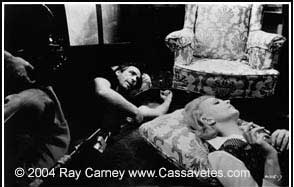 ....There
is a homogenized quality to many films so that everyone ends up sounding
(and acting) more
or less the same – the children like little adults, the women like
men with skirts on, and everybody like they know what they want and
need.
A Woman Under the Influence is a celebration of what makes us
different from one another – different in every way: physically,
imaginatively, socially, sexually. Nick's orders-from-headquarters style
of interaction is entirely
different from Mabel's ballerina-like delicacy and vulnerability, and
both are different from everyone else in the movie. ....There
is a homogenized quality to many films so that everyone ends up sounding
(and acting) more
or less the same – the children like little adults, the women like
men with skirts on, and everybody like they know what they want and
need.
A Woman Under the Influence is a celebration of what makes us
different from one another – different in every way: physically,
imaginatively, socially, sexually. Nick's orders-from-headquarters style
of interaction is entirely
different from Mabel's ballerina-like delicacy and vulnerability, and
both are different from everyone else in the movie.
When characters are so deeply
imagined from the inside, they don't have to do anything in particular
to hold our attention. The events in Cassavetes' work are not generated
by what figures do but what they are. Personality becomes
plot. Behavior is narrative. To watch the spaghetti breakfast scene
(or
the family gathering that structurally echoes it at the end of the film)
is to be gripped not by a series of actions, but by a course of emotional
interactions. Living does not involve doing anything but being something – a
much harder task.
 Critics
sometimes talk as if great art gives us new ideas, when it would be more
accurate to say it give us new ways of knowing and feeling. To watch A
Woman Under the Influence is to have our vision cleansed and enriched.
The film transports us out of our old selves. It transforms us. It lets
us see the world under an emotional microscope, registering butterfly
flickers of feeling on faces, hearing dog-frequency vocal flutters. Cassavetes
gives us something much greater than thoughts. He gives us powers –
new capacities of sensitivity and awareness.... Critics
sometimes talk as if great art gives us new ideas, when it would be more
accurate to say it give us new ways of knowing and feeling. To watch A
Woman Under the Influence is to have our vision cleansed and enriched.
The film transports us out of our old selves. It transforms us. It lets
us see the world under an emotional microscope, registering butterfly
flickers of feeling on faces, hearing dog-frequency vocal flutters. Cassavetes
gives us something much greater than thoughts. He gives us powers –
new capacities of sensitivity and awareness....
* * *
....Most films depend on a
shorthand that allows us to view them in a fundamentally different
way
from the way we experience things outside of the movies. They employ
a kind of code: See this. Think that. Get it? Got it. They tell us
what
to know and feel, what things mean. They make points. The result is a
slight but decisive abstraction from everything in them. The viewer
is
always at a certain critical distance from what is on screen. These movies
are about an experience, rather than giving us the experience
itself. Rather than plunging us headlong into life, these movies
tell us about
life – the way reading an essay about an experience is entirely
different from having the experience.
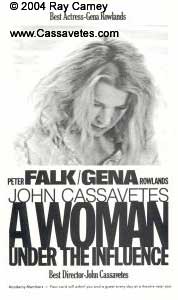 Cassavetes takes away the aboutness,
the abstraction. To watch one of his movies is not to learn about a
group of characters and situations, but to have something very close to
the kind of experiences we would have if we were actually in similar situations
with similar figures. Cassavetes takes away the aboutness,
the abstraction. To watch one of his movies is not to learn about a
group of characters and situations, but to have something very close to
the kind of experiences we would have if we were actually in similar situations
with similar figures.
The secret of Cassavetes' method
is to deny viewers every form of intellectual distance and control. The
experiences he presents can't be held intellectually at arm's length.
They won't be simplified by being translated into received ideas or push-button
emotions. They resist being formulated. They must be challengingly negotiated
moment by moment the way we live and feel things in real life. In all
of their unresolved sprawl and mutability, the experiences in his films
are the opposite of the canned, pre-programmed summaries of experience
most other movies provide....
* * *
....Many of Cassavetes' main
characters function as alter egos for their actor-director
creator, but none more obviously than Mabel. She is the most dazzling
theatrical
presence in all of Cassavetes' work. She is an off-balance ballerina
of intricate choreography, an eccentric entertainer, parodic pantomimist,
and comical mistress of ceremonies. (Though Gena Rowlands is best known
for her intensely serious roles in her husband's films, her exuberant,
mugging performance here and in Gloria reminds us that she began
her acting career as a comedienne in The High Cost of Loving.)
Mabel's deepest similarity with her creator is that she is an improvisatory
writer-director of family scenes – not only herself performing,
but sponsoring performances in others. She gets hard-hats to sing opera
and encourages
her own and neighbor children to become actors and actresses of their
own lives – by turns, imaginatively transforming themselves into
cowboys, dying swans, and pirates.
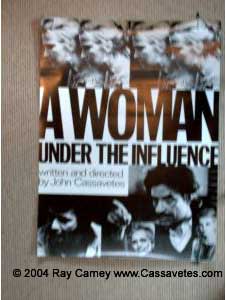 What
interests Cassavetes about Mabel, of course, is not just that she is a
kind of director, but what kind of director she is. He makes a number
of points about her directorial style throughout the film. In the first
place, she is never merely mechanical or technical in her direction, which
is to say, she is less interested in the details and the surface polish
of a performance, than in the depth of emotional exploration it represents.
She shows us that there is no "best" way to direct others and
that she is after no one "right" response. She will do just
about anything to move the figures around her into a deeper place than
merely scripting, blocking out, or dictating their actions ever could.
Sometimes she proceeds by mimicry (as when she comically parodies her
mother's gestures and tones of voice when the kids return home for their
books). At other moments she badgers and nags (as she does with Mr. Jensen,
when all else fails). She can direct with expressions of tenderness (as
when she caresses Billy Tidroe's face or her son's hand). At still other
times, she directs by not directing (as when, in the final gathering,
to cut the tension, she changes the subject away from her hospital stay
and tells jokes to get Mama Longhetti to lighten up). What
interests Cassavetes about Mabel, of course, is not just that she is a
kind of director, but what kind of director she is. He makes a number
of points about her directorial style throughout the film. In the first
place, she is never merely mechanical or technical in her direction, which
is to say, she is less interested in the details and the surface polish
of a performance, than in the depth of emotional exploration it represents.
She shows us that there is no "best" way to direct others and
that she is after no one "right" response. She will do just
about anything to move the figures around her into a deeper place than
merely scripting, blocking out, or dictating their actions ever could.
Sometimes she proceeds by mimicry (as when she comically parodies her
mother's gestures and tones of voice when the kids return home for their
books). At other moments she badgers and nags (as she does with Mr. Jensen,
when all else fails). She can direct with expressions of tenderness (as
when she caresses Billy Tidroe's face or her son's hand). At still other
times, she directs by not directing (as when, in the final gathering,
to cut the tension, she changes the subject away from her hospital stay
and tells jokes to get Mama Longhetti to lighten up).
Another point about directing
that Mabel illustrates is that in order to keep opening up others in this
way, you must yourself remain open. That is to say much of her directing
(especially at the spaghetti-breakfast) simply consists of responding
freely and passionately to others' performances. Directing is not dictation,
but dialogue, a relationship between two people. Mabel is a great listener,
an amazingly alert viewer. Even as she pushes herself and those around
her away from expressive clichés and conventions, she continuously
adjusts her own directorial performance to take account of their discomfort
or anxiety. Even with a cause as lost, an actor as blockheaded and uncooperative
as Mr. Jensen, she keeps changing her performance to respond to his. It's
not accidental that Mabel's idea of directing Mr. Jensen (or, earlier,
Billy Tidroe) is to dance with him. She doesn't impose "her vision"
on others but asks for a kind of mutually responsive partnering.
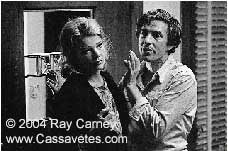 That
leads to the final and most important point about Mabel's directing, which
is that it is for others, not for herself, that she is ultimately working.
Rather than making the actor an extension of her personality, her direction
attempts to elicit answering responses that express their needs and desires.
She encourages her "actors" and "actresses" to dare
to give the performance of their lives, not so that that they will realize
her vision, but that they might explore unrealized parts of themselves
and enlarge their own possibilities. She doesn't want to change them or
make them over in her own image, but to use their possibilities, their
differences from her. That
leads to the final and most important point about Mabel's directing, which
is that it is for others, not for herself, that she is ultimately working.
Rather than making the actor an extension of her personality, her direction
attempts to elicit answering responses that express their needs and desires.
She encourages her "actors" and "actresses" to dare
to give the performance of their lives, not so that that they will realize
her vision, but that they might explore unrealized parts of themselves
and enlarge their own possibilities. She doesn't want to change them or
make them over in her own image, but to use their possibilities, their
differences from her.
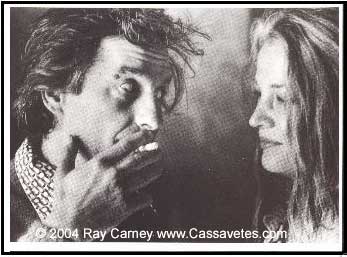 As
should be clear by now, Mabel is John Cassavetes, not in a superficial
biographical sense, but as an embodiment of his vision of life's collaborative
expressive possibilities. Mabel gives us our deepest view of how Cassavetes
actually performed on the set. She aspired to dance with her actors, and
in a metaphoric sense of the term, Cassavetes "danced" with
all of his, partnering them in different ways to elicit original and fresh
responses. (It is not coincidental that many of the most evocative scenes
in Cassavetes' work actually involve dancing, including a wonderful ballroom
sequence cut from the final print of Husbands.) It was in the nature
of Cassavetes' conception of dance – and direction – that
each actor was partnered differently.... As
should be clear by now, Mabel is John Cassavetes, not in a superficial
biographical sense, but as an embodiment of his vision of life's collaborative
expressive possibilities. Mabel gives us our deepest view of how Cassavetes
actually performed on the set. She aspired to dance with her actors, and
in a metaphoric sense of the term, Cassavetes "danced" with
all of his, partnering them in different ways to elicit original and fresh
responses. (It is not coincidental that many of the most evocative scenes
in Cassavetes' work actually involve dancing, including a wonderful ballroom
sequence cut from the final print of Husbands.) It was in the nature
of Cassavetes' conception of dance – and direction – that
each actor was partnered differently....
To read more about the limitations
of contemporary criticism, see "Sargent and Criticism" in the
Paintings section, "Capra and Criticism" in the Frank
Capra section, and "Skepticism and Faith," "Irony and
Truth," "Looking without Seeing," and other pieces in the
Academic Animadversions section. To obtain more information about
Ray Carney's writing on contemporary criticism, click
here
This
page only contains excerpts and selected passages from Ray Carney's writing
about John Cassavetes. To obtain the complete text as well as the complete
texts of many pieces about Cassavetes that are not included on the web
site, click
here.
|









